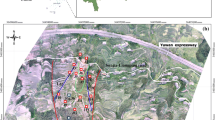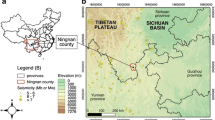Abstract
Landslides caused by heavy rainfall are among the most frequent geological hazards. The steep slope of the landslide, the poor stability of the slippery soil and rock, and the continuous increase in the water content by heavy rainfall make it considerably easy for secondary derivative disasters to occur during emergency rescue operations, seriously threatening the lives of rescue teams and affected people. Therefore, studying the risk of landslide disaster emergency rescue is vital to ensuring the survival of rescuers and disaster victims. Risk factors of emergency rescue risk are analyzed by a typical landslide rescue case. Then, a comprehensive quantitative method for assessing emergency rescue risks of landslide disasters is constructed. The three dimensions of quantitative methods are the possibility of landslides, the severity of the consequences, and the temporal and spatial sensitivity. The cloud model method is used to evaluate the importance of the evaluation structure of 55 factors by 20 experts. The analytic hierarchy method is used to calculate the weight of each index, and the as low as reasonably practicable principle is used to divide the risk value and risk level. Twenty-four key factors are finally screened based on each factor’s mean, entropy, and over entropy, which are used as quantitative risk indicators for landslide disaster emergency rescue. The four levels of emergency rescue risk are divided. Verification is conducted using a landslide disaster rescue case as an example to demonstrate the feasibility of the quantitative risk method. This study confirms that the possibility, severity, and sensitivity of the three risk quantification dimensions of emergency rescue in landslide disasters can more comprehensively summarize the various risk factors in the disposal process.






Similar content being viewed by others
Data availability
Data will be made available on request.
References
Alam E, Ray-Bennett NS (2021) Disaster risk governance for district-level landslide risk management in Bangladesh. Int J Disast Risk Re 59:102220
Anbalagan R, Singh B (1996) Landslide hazard and risk assessment mapping of mountainous terrains—a case study from Kumaun Himalaya India. Eng Geol 43:237–246
Berger W, Coutinho ESF, Figueira I, Portella CM, Luz MP, Neylan TC, Marmar CR, Mendlow MV (2012) Rescuers at risk: a systematic review and meta-regression analysis of the worldwide current prevalence and correlates of PTSD in rescue workers. Soc Psychiatry Psychiatr Epidemiol 47:1001–1011
Bortolin M, Ciottone GR (2016) Disaster medicine. Trauma team dynamics: a trauma crisis resource management manual. Springer, Berlin, pp 203–207
Crawford G, Williams C (1985) A note on the analysis of subjective judgment matrices. J Math Psychol 29:387–405
Dai FC, Lee CF, Ngai YY (2002) Landslide risk assessment and management: an overview. Eng Geol 64:65–87
Durham TW, McCammon SL, Allison JR (1985) The psychological impact of disaster on rescue personnel. Ann Emerg Med 14:664–668
Eliseeva MA, Malovik CN (2015) Sensitivity assessment in risk management, scientific Israel. Technol Adv 17:142–148
Fell R (1994) Landslide risk assessment and acceptable risk. Can Geotech J 31:261–272
Ferrero AM, Migliazza M (2013) Landslide Transportation network and lifelines: rockfall and debris flow. Landslide science and practice: volume 6: risk assessment, management and mitigation. Springer, Berlin, pp 161–170
Finlay PJ, Fell R, Maguire PK (1997) The relationship between the probability of landslide occurrence and rainfall. Can Geotech J 34:811–824
Gao Y, Li B, Gao HY, Lc Chen, Wang YF (2020) Dynamic characteristics of high-elevation and long-runout landslides in the Emeishan basalt area: a case study of the Shuicheng “7.23” landslide in Guizhou. China. Landslides 17:1663–1677
Geertsema M, Highland L, Vaugeouis L (2009) Environmental impact of landslides. Landslides-disaster risk reduction. Springer, Berlin, pp 589–607
Gibson AD, Culshaw MG, Dashwood C, Pennington CVL (2013) Landslide management in the UK-the problem of managing hazards in a “low-risk” environment. Landslides 10:599–610
Hao J, Liu L, Long Z, Chu Y, Zhang D, Chen X, Huang C (2023) Scenario deduction of Natech accident based on dynamic Bayesian network: a case study of landslide accident in a liquor storage tank area in Guizhou Province, China. J Loss Prevent Proc 83:105067
He SZ, Zhai JY (2021) The rescue and relief plan based on the risk assessment of debris flow in Yunnan province, China. Nat Hazards Res 1:134–144
Hungr O (2018) A review of landslide hazard and risk assessment methodology. In: Landslides and engineered slopes. Experience, theory and practice. South Wales, London, pp 3–27
Karimi I, Hüllermeier E (2007) Risk assessment system of natural hazards: a new approach based on fuzzy probability. Fuzzy Set Syst 158:987–999
Lacasse S, Nadim F, Lacasse S, Nadim F (2009) Landslide risk assessment and mitigation strategy. Landslides-disaster risk reduction. Springer, Berlin, pp 31–61
Leonardi G, Palamara R, Suraci F (2020) A fuzzy methodology to evaluate the landslide risk in road lifelines. Transp Res Pro 45:732–739
Li TC (1994) Landslide disasters and human responses in China. Mt Res Dev 14:341–346
Li WJ, Lin KR, Zhao TTG, Lan T, Chen XH, Du HW, Chen HY (2019) Risk assessment and sensitivity analysis of flash floods in ungauged basins using coupled hydrologic and hydrodynamic models. J Hydrol 572:108–120
Li Q, Zhou SN, Wang ZQ (2021) Quantitative risk assessment of explosion rescue by integrating CFD modeling with GRNN. Process Saf Environ 154:291–305
Li JY, Huang Z, Wang HS, Ding H, Jia QL, Zhao W, Le T, Jameel D, Wang PF (2024) Multi-index comprehensive evaluation model for assessing risk to trainees in an emergency rescue training base for building collapse. Sci Rep 14:4792
Liu DF, Wang D, Wu JC, Wang YK, Wang LC, Zou XQ, Chen YF, Chen X (2014) A risk assessment method based on RBF artificial neural network-cloud model for urban water hazard. J Intell Fuzzy Syst 27:2409–2416
Lunde A, Njå O (2019) Rescue performance in Norwegian road related avalanche incidents. Cold Reg Sci Technol 165:102774
Luo TY, Wu C, Duan LX (2018) Fishbone diagram and risk matrix analysis method and its application in safety assessment of natural gas spherical tank. J Clean Prod 174:296–304
Mao X, Fung OWM, Hu X, Loke AY (2018) Psychological impacts of disaster on rescue workers: a review of the literature. Int J Disast Risk Re 27:602–617
Melchers RE (2001) On the ALARP approach to risk management. Reliab Eng Syst Safe 71:201–208
Morren M, Dirkzwager AJE, Kessels FJM, Yzermans CJ (2007) The influence of a disaster on the health of rescue workers: a longitudinal study. CMAJ 176:1279–1283
Perrin MA, Digrande L, Wheeler K, Thorpe L, Farfei M, Brackbill R (2007) Differences in PTSD prevalence and associated risk factors among World Trade Center disaster rescue and recovery workers. AMJ Psychiat 164:1385–1394
Petley D (2012) Global patterns of loss of life from landslides. Geology 40:927–930
Rake EL (2004) A risk-informed approach to decision making in rescue operations. In: Paper presented at the probabilistic safety assessment and management (PSAM7/ESREL04) Berlin
Saaty TL, Vargas LG (1987) Uncertainty and rank order in the analytic hierarchy process. Eur J Oper Res 32:107–117
Sardi MF, Razak KA (2019) Assessment of effectiveness of emergency response time during landslide event in Malaysia. ASM Sci J 12:1–19
Selman J, Spickett J, Jansz J, Mullins B (2019) Confined space rescue: a proposed procedure to reduce the risks. Saf Sci 113:78–90
Sultana N, Tan S (2021) Landslide mitigation strategies in southeast Bangladesh: lessons learned from the institutional responses. Int J Disast Risk Re 62:102402
Taflanidis, AA (2011) Seismic risk assessment and sensitivity analysis in terms of life-cycle repair cost. In: Paper presented at the first international symposium on uncertainty modeling and analysis and management; and fifth international symposium on uncertainty modeling and anaylsis (ISUMA), Maryland
The Ministry of Emergency Management, PRC (2020) The Ministry of Emergency Management announced the top 10 natural disasters in 2019. https://www.mem.gov.cn/xw/bndt/202001/t20200112_343410.shtml
Turner AK (2018) Social and environmental impacts of landslides. Innov Infrastruct Solut 3:25–27
Varnes DJ (1984) Landslide hazard zonation: a review of principles and practice. Unesco, Paris, pp 60–61
Vranken L, Vantilt G, Eeckhaut MVD, Vandekerckhove L, Poesen J (2015) Landslide risk assessment in a densely populated hilly area. Landslides 12:787–798
Wang D, Hao MM, Chen S, Meng Z, Jiang D, Ding FY (2021) Assessment of landslide susceptibility and risk factors in China. Nat Hazards 108:3045–3059
Wang X, Liang XD, Li XY, Luo P (2022) An integrated multiattribute group decision-making approach for risk assessment in aviation emergency rescue. Int J Aerospace Eng 2022:9713921
Wu H, Liu S, Liu DH, Wang JW (2020) Hse risk assessment of major sewage transport tunnel projects at the construction stage based on the structuralentropy weight method and the cloud model. Adv civil Eng. 2020:8882903
Xiong WT, Guo Y, Yang QQ, Yang KW, Gao YY, Tian Y (2020) Risk assessment for search and rescue ships based on back propagation neural network. In: Paper presented at the 2020 6th international conference on big data and information analytics (BigDIA), Deqing
Yao L, Xia CX, Ma SY, Qi WH, Nie GZ, Li HY (2023) Lethality level analysis of secondary landslides based on field survey data: a case study of Luding earthquake. Landslides 21:583–605
Zheng Q, Shen SL, Zhou AN, Cai H (2019) Investigation of landslides that occurred in august on the Chengdu-Kunming railway, Sichuan, China. Geosciences 9:497
Zhu YR, Qiu HJ, Yang DD, Liu ZJ, Ma SY, Pei YQ, He JY, Du C, Sun HS (2021) Pre-and post-failure spatiotemporal evolution of loess landslides: a case study of the Jiangou landslide in Ledu, China. Landslides 18:3475–3484
Funding
Guizhou Province Science and Technology Plan project “Shale Gas Mining overflow blowout risk warning Technology Research” (Guizhou Science and Technology Support [2023] General 163); Guizhou Provincial Science and Technology Plan Project “Research on Key Technologies of Rescue Simulation Based on Rainstorm, Slide-debris flow disaster chain Scenario Construction”.
Author information
Authors and Affiliations
Contributions
All authors contributed to the study conception and design. Material preparation, data collection, and analysis were performed by Caiynan Dai, Chenglong Ma, Wenkun Wang and Yun Luo. The first draft of the manuscript was written by Mengyao Wang and all authors comment on previous versions of the manuscript. All authors read and approved the final manuscript.
Corresponding author
Ethics declarations
Conflict of interest
The authors declare that they have no known competing financial interests or personal relationships that could have appeared to influence the work reported in this paper.
Additional information
Publisher's Note
Springer Nature remains neutral with regard to jurisdictional claims in published maps and institutional affiliations.
Rights and permissions
Springer Nature or its licensor (e.g. a society or other partner) holds exclusive rights to this article under a publishing agreement with the author(s) or other rightsholder(s); author self-archiving of the accepted manuscript version of this article is solely governed by the terms of such publishing agreement and applicable law.
About this article
Cite this article
Wang, M., Wang, W., Dai, C. et al. Risk analysis and evaluation of emergency rescue in landslide disaster. Nat Hazards 120, 14809–14835 (2024). https://doi.org/10.1007/s11069-024-06811-x
Received:
Accepted:
Published:
Issue date:
DOI: https://doi.org/10.1007/s11069-024-06811-x




